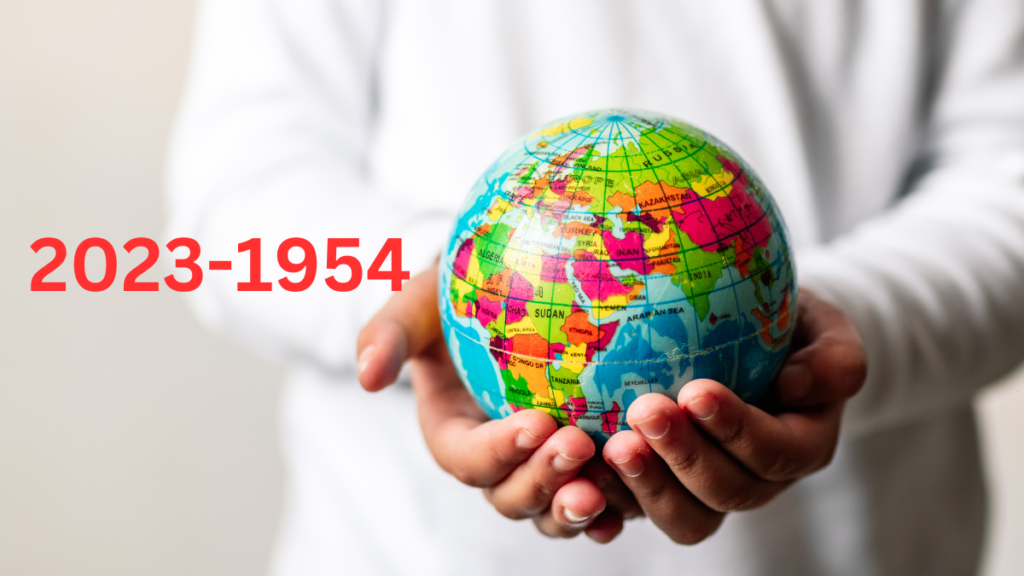A Journey from 2023 to 1954

A trip from 2023 to 1954
A trip in the dimensions of imagination. We make an up-close examination of how it is possible to return from 2023, with its bustling tech-driven scenery, back to the relatively peaceful period of 1954. For cultural shifts ahead of their time, the 1950s was a forerunner. Over recent months we have made brief visits to various parts of this world, but what specifically we have seen is a society in transition. The pace of life changes radically from period to period. This is a land of contrasts between the two periods; a land in which attitudes to life evolve and melt into new forms. This is a land full of sharp contrasts between 2023 and 1954.
Read more: Longantaxi.com
Read Also:What is 1337x?
1954 Events
History is not merely an accumulation of dates and events, but a complex tapestry woven from the threads of human achievements and aspirations. The year 1954 is a turning point in this expansive sequence, marked by groundbreaking inventions and cultural landmarks. It witnessed the end of colonial empires and the birth of newly independent nations across India-Malaya-Burma, Vietnam under Ho Chi Minh echoes global yearnings for independence and self-determination.
The dawn of color television was upon us in the technological sphere, transforming entertainment and how we view information. This was also the period which saw rock ‘n’ roll emerge as the cultural force of its day, breaking with conventional wisdom in both music and that curtailing our abilities to express ourselves socially. Every one of these shifts played a role in making today ‘s world what it is, showing the links between one event and another and their continuing effect on today’s life situation.
As we move through history’s landscapes, the personal computer stands out as a major technology leap. A concept first hatch in the mid-20th century, personal computers were transforme from luxe items into household necessities and business essentials around the globe.
This revolution in technology led to advances in telecommunications and laid the groundwork for the origins of the Internet. From its beginning, the Internet became the backbone of the digital era, tying into continents digitally and setting the stage for a growth in communication technology. This digital renaissance changed the face of where we get information, interact with media and communicate, marking a major milestone in the history of technology evolution.
Read more: Taxi long an
Also read: B2B Diital marketing
What is 2023 to 1954
In addition to the gigantic leaps and bounds in technology, the difference between 2023 and 1954 is of 69 years. In this period there have been tremendous changes in the global socio-political scene, economically and culturally. Each year within this period brought with it its own unique stories, challenges, successes and lessons that in sum total served to carve out the shape of what we see around us today.
Looking back on these 69 years, it seems more than just a chronological difference; it is the whole rich tapestry of human effort and human accomplishment. As we journey back in time from 2023 to 1954, we watch the unfolding of social movements such Civil Rights and Women’s Lib; we witness global powers rising and falling–Sino-American frictions the end of European colonial rule in Africa–and international alliances taking shape.

Outlook 2023 to 1954
The outlook is entirely different in 2023 than 1954. A certain variety of this technology, a change in the global political landscape and an evolution toward the norms of society make today’s world we live in unique environment that wouldn’t be imaginable 70 years ago. In technology, there have been moments of real significance. We have seen the spread through society of artificial intelligence; we have seen the global community confronting unforeseen difficulties brought about by manmade pollution and unchecked greenhouse gases, and so far within this century witnessed two rich nations elect major political paths that will change international relationships.
Reverting to 1954, the world was in a state of post-war repair and realignment. The period saw the commencement of the Civil Rights Movement in America, NATO emerging as a significant actor in world politics, and the arrival of color television as a revolution in technology. This Time Two Ends: Together these events portray a simple fact – the great changes that have come about in human history during almost seven decades, demonstrating our collective ability to adapt, innovate, and always to move forward.
read more: Houston Photos
Read also: best 4x Games
Setting the Stage: 2023—A Glimpse into the Future
The year 2023 stands as an inspiration to human creativity and spirit, projecting towards the future through incredible achievement and artificial intelligence design work that will shape tomorrow. This era is characterized by its heavy reliance and development of artificial intelligence that has penetrated every aspect of daily life from healthcare to personalized education platforms. Capitalizing on these AI systems in fighting climate change represents a new departure from conventional dealing with one of humanityˈs most pressing problems.
Furthermore, 2023 as a new platform will see significant political reorganization, with countries struggling over how to fight the digital war -and cyber security necessary policy instruments or viable different structures for sustainable economy development at least among objectivly western nations alone The juxtaposition of advanced technology with existing social problems presents a complex yet hopeful picture for the future. In sum, this period marks a shift towards a more just and equitable life through the abolishment of long-established barriers and increased cooperation between countries worldwide.
Read more: aggregate-marks-meaning
Read Also: Milialar
Innovation in Technology (1954-1970)
The fourteen years from 1954 to 1970 witness a surge of technological innovation, entering what may be considered the bid for development and knowledge which today provides foundation for our modern digital era. This stretch witnessed the introduction and refinement of a number of technologies that have since become taken for granted. In 1954, the world witnessed the introduction of the silicon transistor, a huge lead which eventually led to miniaturization of things electronic and the modern computer age. Then in 1958 Jack Kilby invented the integrated circuit, further revolutionising electronic computation by making devices smaller, faster and more reliable.
The space race, typified by the 1969 Apollo 11 moon landing not only demonstrated human ingenuity and possibility for space exploration but also brought leaps in telecommunication, materials science and computing advances. Also during this era, the internet’s foundations were laid with ARPANET’s development in 1969, setting up today’s network of global interconnectedness. These great innovations signal an age of fast technological advancement, which changed society’s structure and entered onto a course for future developments.
ERA Moving into the 3rd Millennium 1971-1990
The 19 years from 1971 to 1990 symbolised a period of digital escalation and globalisation. They also continued the development of technology which began in mid 20th century. The invention of the microprocessor by Intel in 1971 ushered in the era of personal computer, paving the way for technology to be brought to the general public and the Information Age to start. During this phase, the Internet Protocol Suite (TCP/IP) was confirmed in 1982, providing required architecture for internet to become a global network. T
he 1980s saw the explosion of personal computing, with Apple’s Macintosh being launched on the market. It featured graphical user interface and a mouse, thus transforming how people interacted with technology. Meanwhile, the collapse of the Soviet Union in 1991 and the Cold War at end symbolised a significant geopolitical change which cleared the decks for a new world order assumed global interconnectedness and cooperation as its central tenet. This era pre-empted the internet and digital culture which exploded in future decades, indicating an acceleration of innovation and the dawn digital communications revolution which defined late 20th and early 21st centuries.
Global Shifts: 1991-2010
Significant global shifts happened in the period between 1991 and 2010. This time both in technology and geopolitics. The world changed totally after Tim Berners-Lee ‘s World Wide Web came out in 1991. While it was only a small thing for him at first–just an experiment–the modern internet today can be seen as essentially issuing from that single instant. Mobile technology made its debut in this era too, and it also ushered in the dawn of the digital economy: IBM ‘ s first smartphone rolled out in 1994; later giants such as Amazon and eBay became e-commerce businesses.
On the diplomatic front The early 1990sbring the end of apartheid in South Africa. This was a major step forward for human rights globally. The European Union was established in 1993, following the Maastricht Treaty. It was a reflection of global trends toward economic globalization. In terms of ecological problems, the Kyoto Protocol of 1997 established a worldwide consensus on combating climate change. These important developments highlight the fact that technological advances, economic policy changes, and political agreements are all interconnected in shaping a globalized era. They set the stage for challenges and opportunities facing our 21st century.
Read more:Web&Store
The Dawn of a New Era: 2011-2023
Every aspect of human life has been heavily digitized since 2011, with digital technology integrating into the mainstream. This era saw the ubiquity of artificial intelligence and machine learning which changed not only operations in business but also life’s many little advantages–from smart home appliances to customised medical care solutions. Social media platforms rose to power, radically transforming how modern communications are carried out. It allowed people all over the world to exchange messages in real time and communicate back and forth, so creating public opinion for one another almost like second nature. The spread of the gig economy and blockchain technology also raised new questions for employment and finance, shaking old ideas about work and money.
Even as the world moved forward on technology, it faced major challenges: a global pandemic due to COVID-19 in 2020 that led to work and study geared mostly online. This speeding up of digital transformation couple with extreme attention paid to technology’s indispensable role in managing and smoothly getting through emergencies and disasters was unthinkable before as, in the past, such interests were never give top priority. Urgency for environmental guardianship also loomed large, as the need to find clean energy sources became an ever greater reality.
The years between 2011 and 2023 have been times of rapid technological development and global challenges–also a demonstration of the adaptability of humanity,s evolution toward its increasingly connected but sustainably based future. While setting the stage for future technological advancements This period also stress the importance of ethical considerations and that advancement cannot ignore equitable access.
Rapid Technological Changes
After 2023, if technological advancements were accelerating, that would indeed quite completely remodel human society once again. This could be true especially with emerging technologies such as quantum computing, a force capable of bagging out further new territories on the one hand; while contrariwise the expansion of Internet-of-things technology (which connects ordinary objects to it), achieved through other digitalized touchpoints What this picture for a future might mean is that digital integration becomes yet more simplified at every level.
Biotechnology and genetic engineering are also a possiblity. Both have already quickly contribute to some advances in medicine because genomics means medicine is make from the human body at this same level as if for anything else possible, and it is similarly possible to see diseases will disappear completely (such formula contests on bacteria settings starting with none-outcome positive ones) or really just become a thing of minor morbidity. These days, along with such advances in the field of biotech like those mention above, bring all around faster medical help for everyone who needs it; many diseases still plaguing countries all over the world can at last be exterminate fully. In addition to these advances, autonomous vehicles and drone technology look likely to revolutionize transportation and logistics, making them safer, more efficient.
Era of Rapid Advancement
History Is Being Written in This Era of Rapid Advancement. This is a uniquely pivotal time in history. Innovation is always coming up with something new, breaking open whole new fields; when we look back at different times from this viewpoint that is what we must bear in mind to be successful. It offers us an opportunity for doing good that has never existed anywhere on earth before. And yet as society continues moving forward through these present moments, so future uncertainties too arise from within the crannies of issues which cannot possibly give way to closure in their own right without substantial deliberation–both responsible and highly farsighted.
Summary
In short, the train has been general, since the beginning of the 1990 through to 2023 stage have significant technological revolutions, geopolitical changes and environmental milestones that make waves in global landscape. From mobile technology and digital platforms to penetration by digital technology became the mainstream background of social transition.
What was once 2011 to 2023 thus came of age with if digital technologies matured through social media, all place and even, in a word, ways of living. While the year 2023 face challenges like Covid-19 pandemic and nights were consume by dilemmas over ecological crises, there was also a steady stream of advances in technology; from here emerges astonishing scientific exploration tomorrow will never know end. It was an age where rapid change was routine, one side Innovation in pursuit of benefit; on the other hand sustainability must be consider equally indeed ethical factors and universal freedom of access were intertwine into daily life.
FAQs 2023-1954
Q: How has artificial intelligence (AI) evolved from 1954 to 2023?
A: AI has evolved remarkably from its conceptual beginnings in 1954 to sophisticated machine learning algorithms and neural networks by 2023, driving significant advancements in various sectors including healthcare, finance, and autonomous vehicles.
Q: What role did the internet play in societal changes between 1990 and 2023?
A: the internet sat between global communication, commerce and information flow, becoming an element in everyday life that caused social, economic or political change worldwide.
Q: How did the COVID-19 pandemic accelerate digital transformation?
A: Together with co-options of digital backbone industries across all sectors, the pandemic sped up such well-integrated solutions and miniaturizations as remote work and study.
Q: What advances in space exploration occurred from 2011 to 2023?
A: Important advances included joint ventures on Mars missions, establishment of lunar bases as well as the launch deep space probes; one age gave rise to a completely new field of astronomy and another makes interplanetary flights possible.
Q: How have advances in renewable energy addressed climate change issues by 2023?
A: Innovations in solar, wind and other renewable sources of energy have helped to appreciably reduce the carbon emissions which come with using fossil fuels–all substantial progress towards reining in its environmental impact on us all.
Q: What impact did blockchain technology have on financial transactions by 2023?
A: By providing greater transparency, security and efficiency in transactions blockchain brought about a revolution in finance so that both cryptocurrencies decentralized financial services were born at once.






